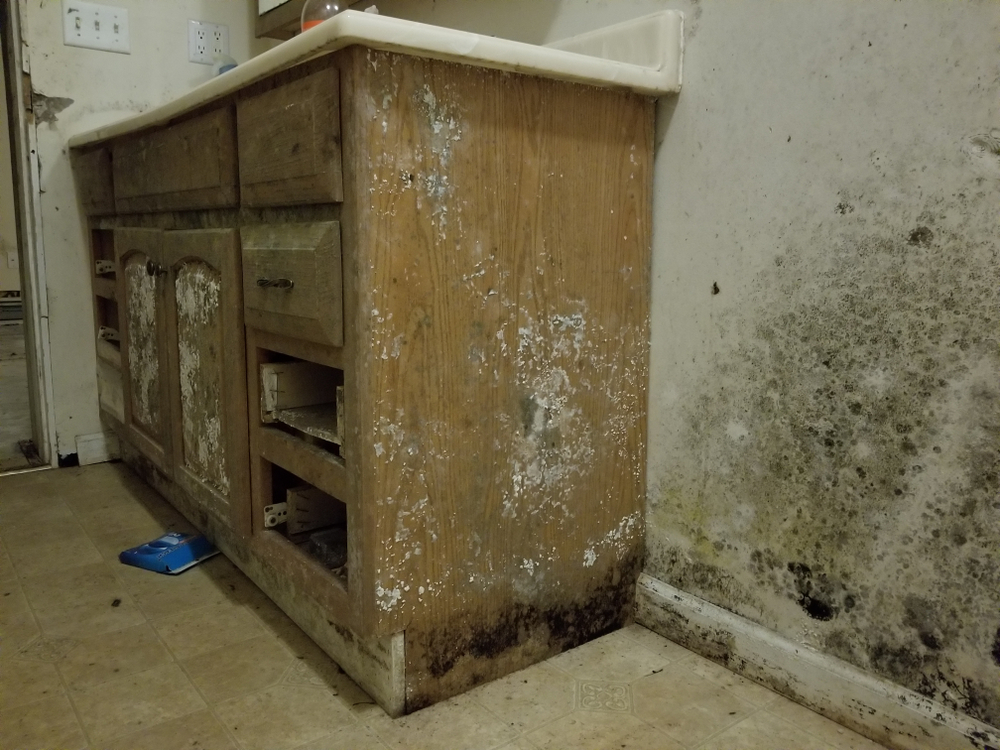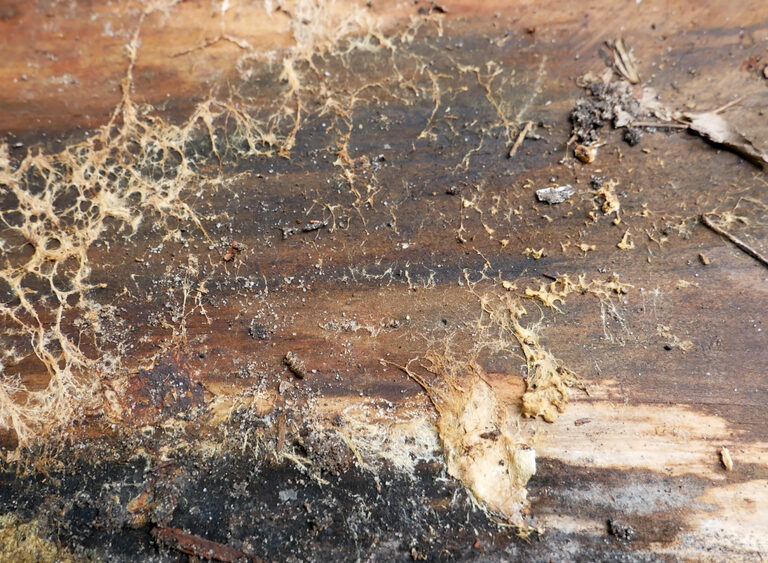Wood is naturally hygroscopic, meaning it attracts and holds water. This makes wood an ideal place for mold and mildew to grow. Of course, this leads to unsightly discoloration and foul odors, with the potential for much bigger problems—like health issues.
But before you jump into killing mold, you should understand what mold is and how it can affect your home and health.
A Quick Overview of Mold
Mold is a catchall term for a variety of fungal species found throughout the world. You may have seen mold on bread or leftovers in your fridge, but mold can also grow on virtually any other surface, provided conditions are optimal for their survival.
Where Does Mold Come From?
Mold is everywhere, but it typically originates outdoors. Mold spores travel indoors through open airways and often find comfort in our indoor, temperature-controlled environments.
When the spores inoculate surfaces in a suitable environment, it results in mold growth. A suitable environment for mold is a moist one, so any area that is constantly exposed to high humidity and shielded from extreme temperatures and UV exposure is a potential home for mold.
Is Mold Harmful to Your Health?
The answer depends on both you and the type of mold. Since mold is everywhere, you’re constantly exposed to small amounts of it. And while minute amounts of mold won’t typically cause you any problems, larger amounts can trigger allergies and cause irritation.
Some molds also create harmful compounds called mycotoxins. These are toxic chemicals that can cause illness and other major maladies, especially if you’re immunocompromised or suffer from respiratory problems.
Other Negative Implications of Mold
While mold may not cause substantial health problems for everyone, it can cause other significant problems. Particularly, mold can compromise the structural integrity of porous surfaces, leading to weakening bonds and rot.
This means that eradicating mold from your home is not only important for your health, but for your home’s health as well.
Mold Removal Preparation
When removing mold from wood (or any surface, for that matter), proper preparation is key. This means gathering supplies and prepping the area for removal.
Gather Your Cleaning Supplies
After you’ve gathered your protective gear, you’ll want to gather some cleaning supplies. These includes:
- A vacuum cleaner with a HEPA filter
- A spray bottle
- A soft-bristle brush
- A microfiber cloth
- Warm water
- Dish soap
- White vinegar
- Tea tree oil
- Wood cleaner
- Borax
- Sandpaper
- Sanding block (optional)
Wear Protective Gear
Since mold can wreak havoc on your health if you inhale or ingest it, it’s important that you wear the proper protective gear.
Before interacting with the moldy area, you’ll want to wear safety goggles and a respirator to keep stray mold spores from getting in your eyes, nose, and mouth. You’ll also want to wear rubber gloves to avoid making contact with the mold or your cleaning solution; both can irritate your skin.
Vacuum the Area
Before you start removing the mold, you should vacuum the immediate and surrounding areas with a HEPA filter-equipped vacuum cleaner. This will help capture any loose mold spores, which can help prevent future problems.
Once you’ve vacuumed the area thoroughly, take the vacuum outside. To properly dispose of the contents, empty the vacuum into a plastic bag and seal it tight to avoid allowing the mold spores to escape. If you’re using a bagless vacuum, you may want to also wash the canister.

Removing Mold on Wood
Once you’ve prepped the wood for mold removal, it’s time to get to it. Depending on the severity of the infestation, you may need to utilize multiple of the below solutions to effectively rid the wood of mold completely. We’ll outline our favorite strategies for mold removal below, but first, a word of warning.
Avoid Using Bleach
Before we jump into mold cleaning solutions, you should know that you shouldn’t use bleach to kill mold on wood.
While bleach is effective at killing surface-level mold on non-porous surfaces, the chlorine found in bleach can’t penetrate wood. This means that you’ll only be killing the mold on the surface and also providing additional moisture for the underlying membrane deeper in the wood.
Not only will this membrane survive, but it can identify bleach as a threat and respond by ramping up growth in order to increase its chances of survival. This means that the problem will eventually return, and it may come back worse than before.
Using Dish Soap
If you catch mold growing on wood quick enough, you may be able to kill it by using a simple solution of dish soap and warm water. This also works well on painted or sealed wood.
- Mix roughly 1 teaspoon of dish soap with warm water and pour it into your spray bottle.
- Spray the affected area with the solution and use a soft-bristled brush to scrub the area.
- Dab the area with a microfiber cloth to remove excess liquid and then dry thoroughly.
- Once dry, treat it with a wood cleaner to help maintain the wood in the future.
Using Vinegar
If you have mold growing on untreated wood, you’ll have to step your removal tactics up a level. Vinegar, particularly white vinegar, is a great alternative to bleach and will easily kill over 80% of all types of mold.
- You’ll want to use vinegar that contains at least 5% acidity (most household vinegar contains 5-8% acetic acid).
- Start by filling your spray bottle with straight white vinegar. You won’t want to dilute it with water, or you’ll hamper its effectiveness.
- Spray the moldy area thoroughly with the vinegar and scrub it with a brush.
- After you’ve sprayed and scrubbed, let the vinegar dry on its own. This will allow it to soak into the wood and kill the mold at its source.
Using Tea Tree Oil
Tea tree oil is another great way to kill mold on untreated wood, thanks to its antifungal properties. In fact, tea tree oil may work better at inhibiting mold growth than vinegar and other types of mold inhibitors. Just remember to use caution when handling tea tree oil, as it is toxic if ingested and can irritate your skin.
- Mix 2 teaspoons of tea tree oil with 2 cups of warm water in a spray bottle.
- Thoroughly spray the moldy area with the solution and scrub it with a soft-bristle brush.
- Allow the solution to set for at least 10 minutes, then dab the wood dry with a microfiber cloth.
Using Borax
If vinegar or tea tree oil don’t do the trick, then borax might. Borax is an alkaline mineral salt that works a bit differently than the other things we’ve mentioned.
Instead of acting directly as a fungicide, borax utilizes its high alkalinity to create an inhospitable environment for mold to live in. Most molds prefer to live in moderately acidic or neutral environments (usually in the 3 to 7 pH range). Borax has a pH of 9.13 and is water-soluble, making it effective for treating wood and killing most mold.
You can choose to make a DIY borax spray solution to help remove mold, or you can make a “paint” to kill it without any removal.
Borax Spray
- Start by mixing 1 cup of borax into a gallon of hot water. Using hot water will help speed up the dissolution.
- Spray the area thoroughly and scrub away the mold.
- Dry the area thoroughly with a microfiber cloth.
- You can optionally follow up with a light spritz of your borax spray to help inhibit future mold growth.
Borax Paint
- To make borax paint, start with 1 cup of borax and 2 quarts of boiling water. Mix it thoroughly so that you’re left with cloudy water.
- Use a paintbrush to coat the surface of the wood where the mold resides.
- Allow the “paint” to dry.
Sanding the Mold Away
If you have a persistent mold problem, and other solutions aren’t resolving it, the mold is likely too deep for simple chemical concoctions to handle. If you can’t replace the wood outright, you can sand it down to physically remove the mold.
- Start by using a 100-grit piece of sandpaper. To make it easier, you may opt for a sanding block to offer a more ergonomic grip. If the moldy area is large, you may opt for an electric sander to get the job done quicker.
- Sand the wood until all the mold is gone. You may optionally finish up with a finer grit of sandpaper if you want a smooth finish. Finishing with a wood cleaner may also help ensure the wood is free of stray mold.
- Clean up the debris with your vacuum to remove residual mold left from sanding.
Tips for Preventing Mold on Wood
Once you finish dealing with a mold problem, you’ll probably want to keep it from coming back. Here are some things you can do to help inhibit mold growth.
Fix Water Problems
Mold lives in moist environments, meaning mold can be symptomatic of a larger issue. For example, if you have mold growing under your kitchen sink, chances are, you have a leak somewhere. Likewise, mold on your ceiling can be indicative of a leaky roof.
Addressing these issues will not only inhibit mold growth, but it can save you a lot of money and headache later on.
Properly Ventilate the Area
By opening some windows and running a fan, you can keep fresh air circulating through the room. Not only will a breeze cool the room, but it can help lower the humidity, thereby reducing mold’s ability to grow.
Use a Dehumidifier
While ventilation is a good way to help bring down humidity, it’s not a perfect solution. If you have a basement, then you know how hard getting adequate ventilation can be. In that case, you’ll want to run a dehumidifier. This will help pull the moisture out of the air and can help prevent mold from growing.
Seal the Wood
Places like bathrooms are a breeding ground for mold, thanks to the constant moisture and lack of ventilation. For wood located in an area that’s regularly exposed to moisture, sealing the wood with a mold-resistant primer or paint is a must. This will prevent the wood from absorbing moisture, protecting it not only from mold, but also rot.
Use a HEPA Air Purifier
Using an air purifier with a HEPA filter is a great way to reduce the number of mold spores in the air. Along with proper moisture control, this will keep mold in check and can help you greatly if you’re allergic to mold.
Finishing Up
Mold can cause trouble for you and your home. While removing mold from non-porous materials is simple, removing it from porous materials like wood requires a slightly different approach, but with a little effort and some DIY concoctions, it can still be done. Follow our handy tips above, and you’ll be well on your way to banishing mold for the long term.
